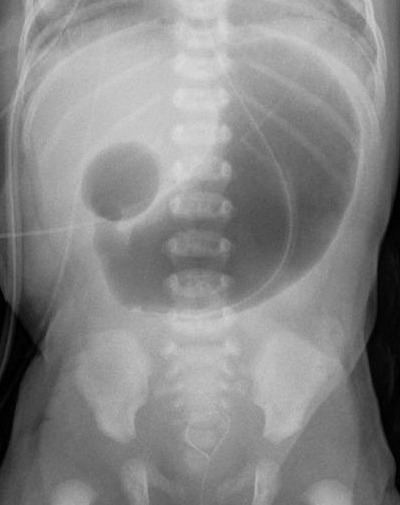Specialty medical genetics ICD-9-CM 751.1 DiseasesDB 31514 | ICD-10 Q41.0 OMIM 223400 MedlinePlus 001131 | |
 | ||
Duodenal atresia, also known as duodenojejunal atresia, is the congenital absence or complete closure of a portion of the lumen of the duodenum. It causes increased levels of amniotic fluid during pregnancy (polyhydramnios) and intestinal obstruction in newborn babies. Radiography shows a distended stomach and distended duodenum, which are separated by the pyloric valve, a finding described as the double-bubble sign.
Contents
- Epidemiology
- Associated conditions
- History and physical examination
- Diagnosis
- Treatment
- Complications
- References
Treatment includes suctioning out any fluid that is trapped in the stomach, providing fluids intravenously, and surgical repair of the intestinal closure.
Epidemiology
Duodenal atresia occurs in 1 in every 5,000–10,000 live births.
Associated conditions
Approximately 20–40 percent of all infants with duodenal atresia have Down syndrome.. Approximately 8% of infants with Down syndrome have duodenal atresia.
History and physical examination
During pregnancy, duodenal atresia is associated with increased amniotic fluid in the uterus, which is called polyhydramnios. This increase in amniotic fluid is caused by the inability of the fetus to swallow the amniotic fluid and absorb it in their digestive tract.
After birth, duodenal atresia may cause abdominal distension, especially of the upper abdomen. Bilious vomiting commonly occurs within the first day of life. The vomiting is described as "bilious", because it contains bile acid.
Diagnosis
The diagnosis of duodenal atresia is usually confirmed by radiography. An X-ray of the abdomen shows two large air filled spaces, the so-called "double bubble" sign. The air is trapped in the stomach and proximal duodenum, which are separated by the pyloric sphincter, creating the appearance of two bubbles visible on x-ray. Since the closure of the duodenum is complete in duodenal atresia, no air is seen in the distal duodenum.
Atresias occurring distal to the duodenum are usually caused by vascular accidents or ischemic insult, such as jejunoileal atresia.
Treatment
Early treatment includes removing fluids from the stomach via a nasogastric tube, and providing fluids intravenously. The definitive treatment for duodenal atresia is surgery (duodenoduodenostomy), which may be performed openly or laparoscopically. The surgery is not urgent. The initial repair has a 5 percent morbidity and mortality rate.
Complications
Prognosis is usually very good, although complications are more likely to occur when there are serious congenital anomalies. Late complications may occur in about 12 percent of patients with duodenal atresia, and the mortality rate for these complications is 6 percent.
